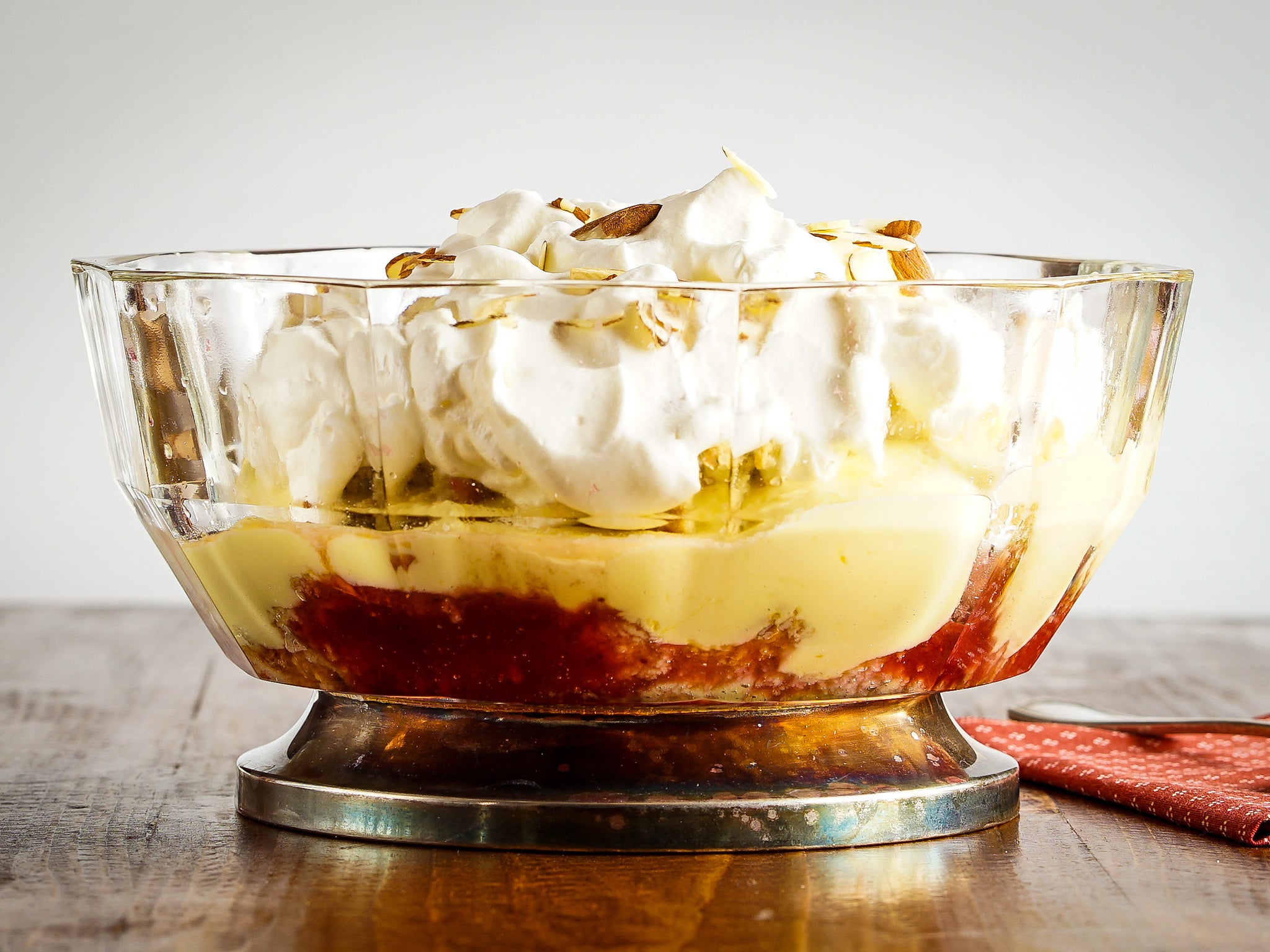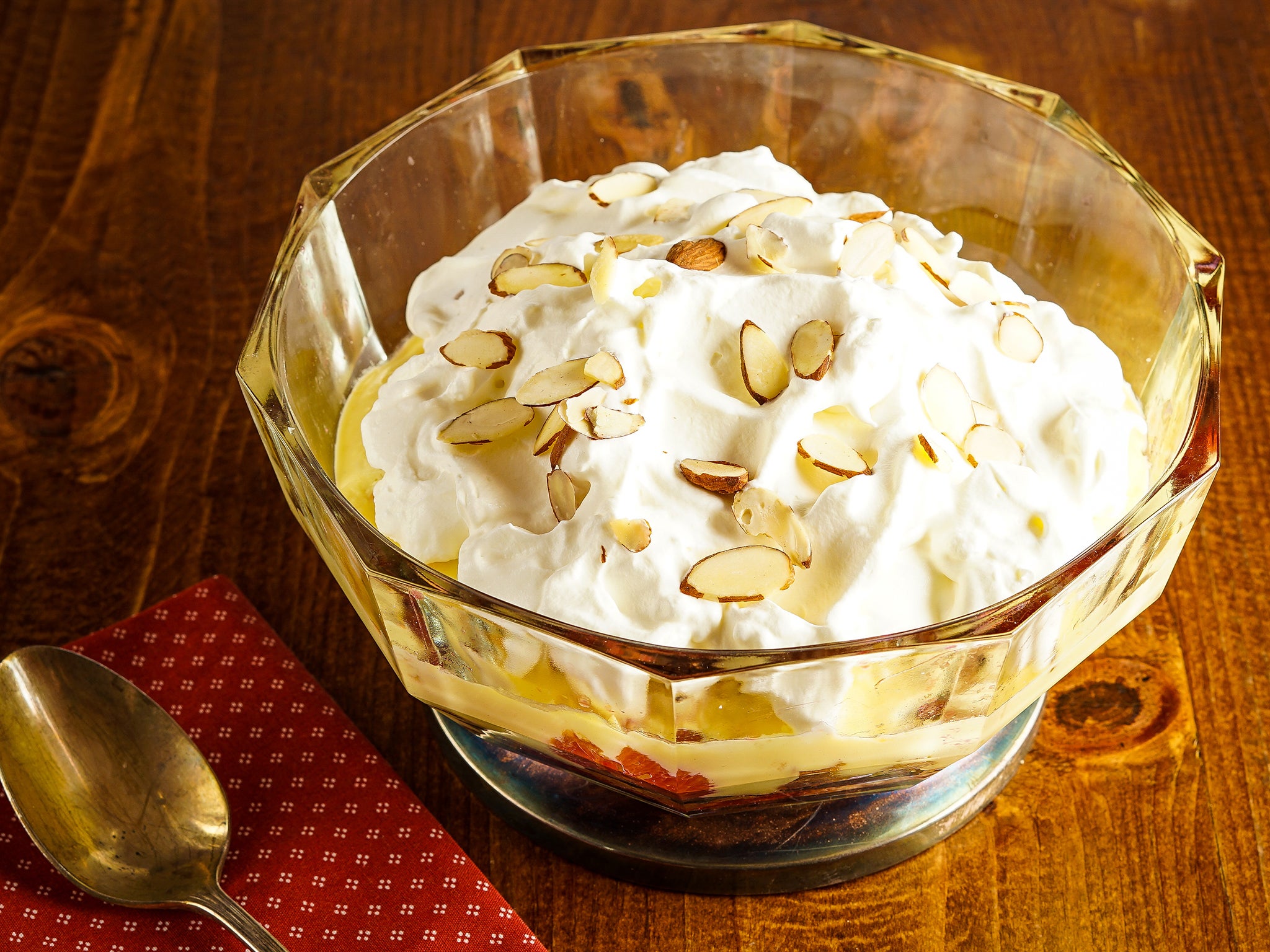How to make a perfect – and spectacular – Christmas trifle
Trifles are as adaptable as desserts get so they’re ideal for the festive season, says Melissa Clark

Your support helps us to tell the story
From reproductive rights to climate change to Big Tech, The Independent is on the ground when the story is developing. Whether it's investigating the financials of Elon Musk's pro-Trump PAC or producing our latest documentary, 'The A Word', which shines a light on the American women fighting for reproductive rights, we know how important it is to parse out the facts from the messaging.
At such a critical moment in US history, we need reporters on the ground. Your donation allows us to keep sending journalists to speak to both sides of the story.
The Independent is trusted by Americans across the entire political spectrum. And unlike many other quality news outlets, we choose not to lock Americans out of our reporting and analysis with paywalls. We believe quality journalism should be available to everyone, paid for by those who can afford it.
Your support makes all the difference.Of all the British puddings with their whimsical names – the roly-poly, the spotted dick, the whim wham and the Eton mess – none is as popular on this side of the pond as a custardy, boozy, cream-topped trifle.
Flamboyant, fruity and exceedingly merry, trifles are a show-off dessert with a self-effacing name.
For all their fanciness, they’re also highly adaptable. As long as you have layers of cake, custard, some kind of fruit or jam (or both), and a fluffy cloud of cream on top, you can vary it as much as you like.
This said, there are, still, a few very loose rules to keep in mind for the best possible result.
The first is about the cake. The anchor of the trifle, the cake layer adds substance to all the ethereal creaminess covering it. But you don’t need to make it from scratch. Store-bought ladyfingers (also called boudoir biscuits) and sponge cake are time-honoured choices. Poundcake and panettone work, too.
Second, you’ll want to consider the soak. Then, make sure the cake is well-doused. Add the sherry or whatever liquid you’re using slowly, giving it a chance to soak in, then add more if you see any dry spots.
Although sweet sherry is the usual choice, Diana Henry, the London-based food writer and author of many cookbooks, including From the Oven to the Table (Mitchell Beazley, 2019), also recommends Madeira, Marsala, port and even whiskey, bourbon and gin.
“Trifle without booze is just sweet,” she wrote in an email.
That said, using a zingy fruit juice paired with its fruit – say, orange juice layered with sugared segments of blood and navel oranges, or apple cider spiked with apple cider vinegar alongside poached or sautéed apples – would work gorgeously in a more temperate dessert.
While the cake doesn’t have to be made from scratch, the custard should be. It should also be thick enough to mound on your spoon so it holds up amid the cream, fruit and cake. Flavour it with plenty of vanilla, citrus zest or spices, or use lemon curd or chocolate pudding instead.
Finally, festoon the top with almonds or amaretti for crunch, or glacéed or fresh fruit for colour, or nothing at all for a more minimalist take. And save the leftovers for the days ahead (it keeps for a few days covered in the fridge).
As Henry contends, if you love all the ingredients you add to the bowl, you really can’t go wrong.
“With trifles,” she wrote, “you should be able to bend and break the rules.”
Classic trifle with berries or citrus

Serves: 6 to 8
Total time: 1 hour, plus chilling
Ingredients:
For the custard:
65g granulated sugar
2 tbsp/20g cornstarch
Pinch of fine sea salt
4 egg yolks
240ml heavy cream
180ml whole milk
Optional flavorings: 1 tsp orange or lemon zest, 1 cinnamon stick or 6 cardamom pods
2 tsp vanilla extract
For the fruit:
200-300g berries or 3 oranges (a mix of blood oranges and navel is pretty)
1 to 2 tsp granulated sugar
For assembly:
About 6 to 8 ladyfingers (also called Savoiardi or boudoir biscuits, or use sponge cake or poundcake), plus more if desired
Berry jam or orange marmalade
60ml sherry, Madeira, dessert wine, brandy or orange juice, plus more as needed
240ml heavy cream
1 tbsp powdered sugar
Sliced almonds, candied citrus peel, crumbled amaretti or berries, for garnish (optional)
Method:
1. Make the custard: in a large bowl, combine sugar, cornstarch and salt. Add egg yolks and whisk until smooth.
2. In a medium saucepan, heat cream, milk and any of the optional flavourings over medium heat until simmering.
3. Slowly whisk 120ml of the hot cream mixture into yolk mixture until well mixed. Whisking egg mixture constantly, slowly pour in remaining cream. Pour the egg mixture back into the saucepan and place it over medium-low heat.
4. Cook custard, stirring continuously especially around the bottom and edges of the pot, until the custard has thickened enough to mound on the spoon, 5 to 10 minutes. Don’t let it come to a boil, but a few simmering bubbles is fine. If it starts to curdle at any point, remove pot from the heat and whisk it intensely. It should smooth out.
5. Once the custard is thick, scrape it into bowl, whisk in vanilla and press a piece of plastic wrap directly onto its surface. Let the custard cool for at least 30 minutes. At this point, custard can be chilled for up to 3 days or used to assemble the trifle. Pluck out cinnamon stick or cardamom pods, if using, just before assembling trifle.
6. Prepare the fruit: if using berries, put them in a bowl, sprinkle with sugar to taste, and use a fork to mash them. If using oranges, supreme them: cut the tops and bottoms off each one, squeezing the juice from the severed pieces into a bowl. Using a paring knife, cut the peel and all the white pith off the fruit. Working over the bowl to catch the juices, slice the segments away from the membrane, letting fruit fall into the bowl. It’s OK if the segments fall apart; you’re going to break them up anyway. When all the segments are cut out of the membranes, squeeze the membranes over the bowl to release as much of the juice as possible. Sprinkle oranges with sugar, to taste, and, using your hands, break the segments up into pieces. You want a pulpy, juicy mix in the bowl. There should be a lot of liquid. Let oranges or the berries macerate for 20 minutes.
7. To assemble the trifle, spread the ladyfingers on one side with a thick layer of jam or marmalade. Put the ladyfingers, jam-side down, in the bottom of a medium trifle dish or any other serving bowl or dish (or use individual dishes, cups or glasses). You want to cover the bottom completely and, if you are using a bowl, go a little bit up the sides; break up the ladyfingers if needed to make them fit.
8. Sprinkle sherry (or whatever liquid you are using) over the ladyfingers, making sure they are well-moistened. Be generous: you don’t want any dry bits.
9. Spoon fruit and all their juices over ladyfingers. Top with custard. If you like a higher cake-to-custard ratio, you can break up a few more ladyfingers and scatter them on top of the custard, then drizzle with more sherry. Press a piece of plastic wrap directly onto the surface and refrigerate for at least 3 hours or up to 24 hours.
10. When ready to serve, using an electric mixer or a whisk, beat the cream and powdered sugar until fluffy; it should hold a light peak. Spoon whipped cream on top of trifle and garnish as you like. Serve immediately (leftovers will keep covered in the refrigerator for 2 or 3 days).
© The New York Times



Join our commenting forum
Join thought-provoking conversations, follow other Independent readers and see their replies
Comments